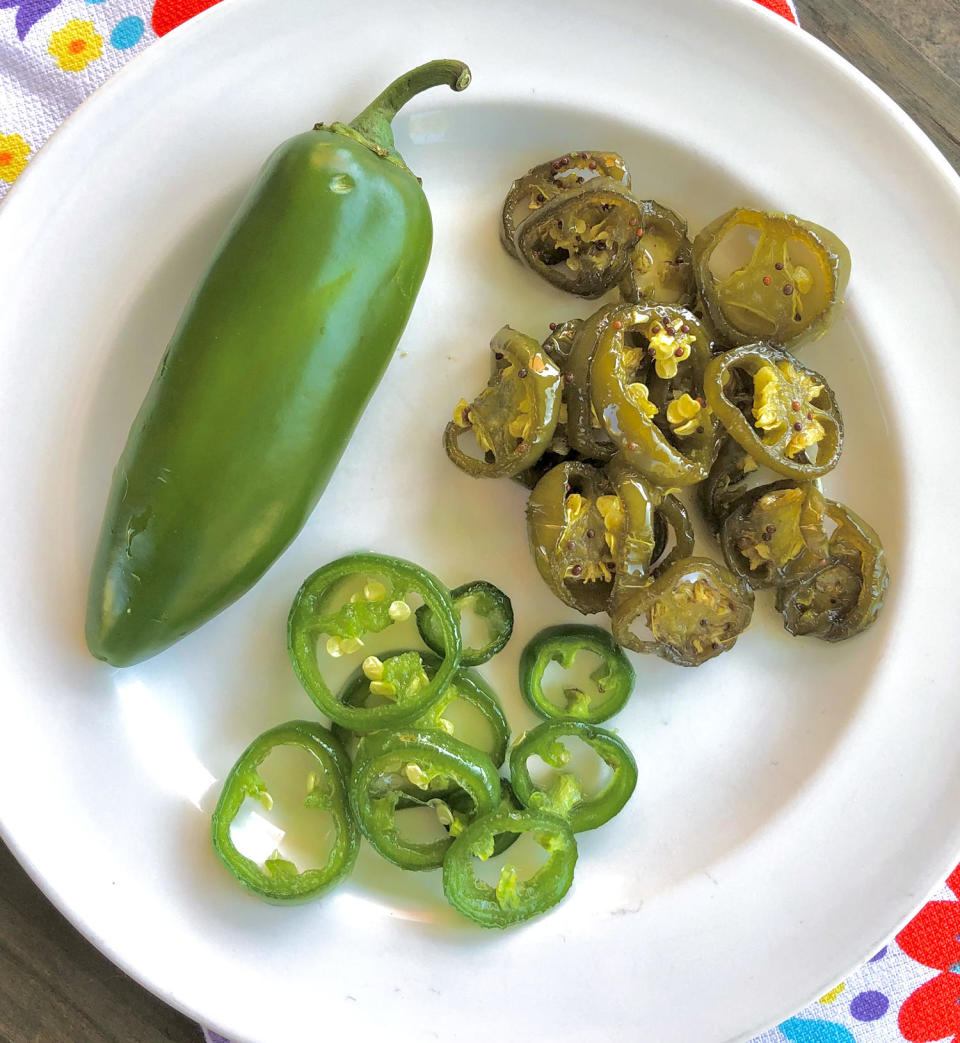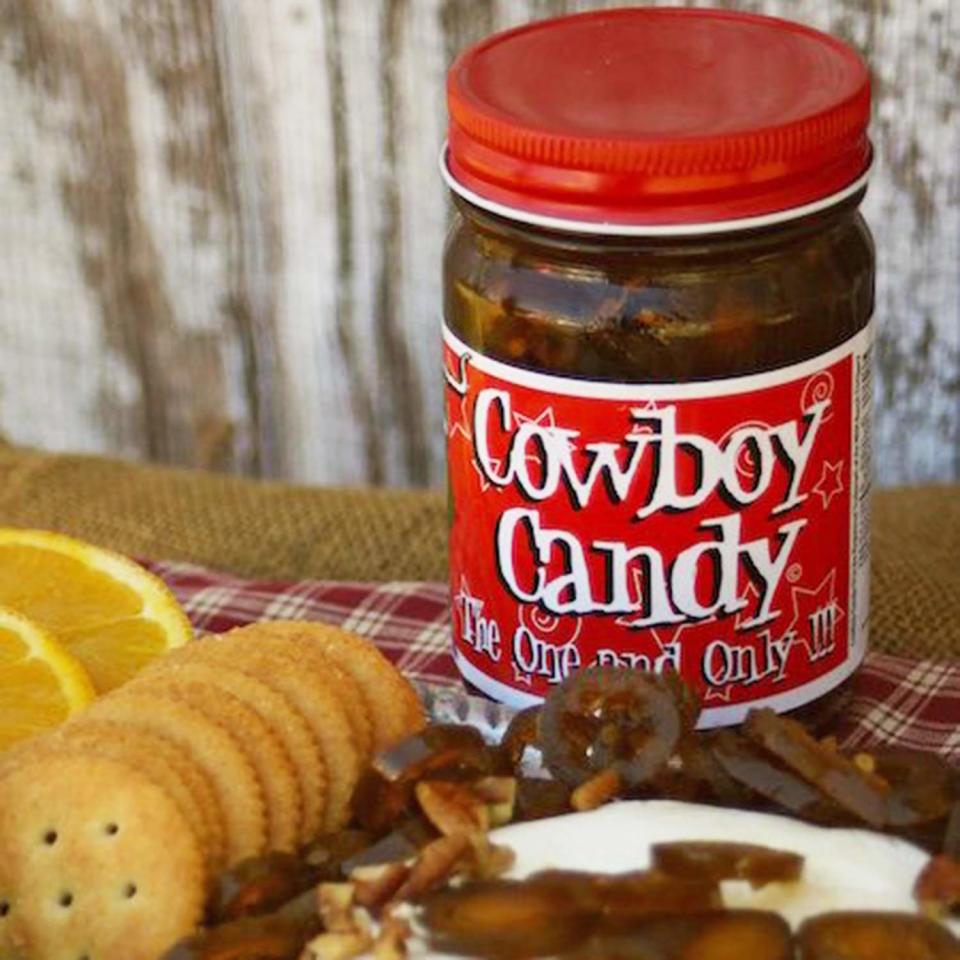What is cowboy candy? All about the internet’s favorite sweet and spicy treat
- Oops!Something went wrong.Please try again later.
Cowboy candy is suddenly everywhere — TikTok, Instagram and YouTube. So what is it? If you ask a Texas old-timer, they might tell you it’s chewing tobacco, but this is a horse of a different color.
The most watched cowboy candy video on TikTok is from sisters Delaney and Shelby of @yessidothecookingg, with over 3.4 million views:
But, in my home state of Texas, jars of this swicy treat have been on the shelves at farmers markets, produce stands and tourist boutiques for as far back as I can remember. Homemade recipes only started making the rounds at the turn of the millennium, though. Most recipes use sugar to vinegar in a ratio of 2:1, or even 3:1, and often the usual pickling spices are added — things like turmeric, mustard seed, celery seed and garlic. Apple cider vinegar is most common, but I use a tip I first picked up from chef Pati Jinich of PBS’s “Pati’s Mexican Table”: rice wine vinegar. It has a more subtle acidity that works well if you’re aiming for sweetness and versatility.
Where is cowboy candy from?
The earliest cookbook example I can find is Robert Berkley’s “Peppers: A Cookbook” from 1992, but it’s “Candied Jalapeños” and uses plain sugar syrup boiled to the hard-ball stage before the peppers are dipped. Commercial cowboy candy is much older than that, though: According to operations manager William Hamzy, WHH Ranch’s original, trademarked version was developed by his great-grandmother Mindie Hamzy in the 1920s when she ran out of cucumbers while making bread and butter pickles.
When it comes to Texas eats, it can be a bear to tell the Tex from the Mex, though. From spicy Amor Chamoy sauce on fruit to beautiful bags of Tamalitoz hard candy, sweet heat is pretty clearly tied to the state’s Mexican roots. Are these really cowboy, or more vaquero? I caught up with Jinich to see whether she could shine some light.
“Since even before the Spanish people got to Mexico, there’s been the technique of preserving chiles in salt, or dried, because you can’t harvest them all year round,” she says. “It varies throughout the regions of Mexico — sometimes it’s dried fruits. I grew up eating tamarind mixed with chile and salt. I think chamoy has to do with that, with preserving.”
But, describing herself as “obsessed” ever since, the first time Jinich had candied jalapeños was while filming a segment for the fascinating docuseries “La Frontera” with chef Larry Delgado in the Rio Grande Valley.
“In Mexico, chipotle chiles can be en adobo or in piloncillo (a kind unrefined sugar),” she says, “but the jalapeños with sugar, I think that exact thing is from Texas.”
How to make cowboy candy
As for the eating, both the vinegared and non-vinegared versions are both fantastic. I suggest making the latter with thin slices instead of the original whole peppers. Boil a ratio of 3 parts sugar to 1 part water until it reaches 250 F on a candy thermometer, stir in sliced peppers for just 30 seconds so they keep their fresh green color, and then remove to a cooling rack to harden. Store refrigerated for up to five days.
For the pickled kind, there are many variations, but in general you need about 1 cup of vinegar and 3 cups of sugar for every pound and a half of fresh jalapeños. Wearing gloves, core them to remove the seeds and white ribs if you want them less spicy (you can see a standard technique in the TikTok above, using a vegetable peeler), and slice them about 1/4-inch thick. Boil the vinegar, sugar and spices for about 5 minutes before adding sliced peppers and simmering for another 5 minutes. As for spices, take your pick, but consider keeping them in the family of seasonings that work well for both savory and sweet, perhaps avoiding garlic and going easy on the mustard seed. In fact, I often add something not common in pickles: cardamom. You can boil the syrup for a few extra minutes after removing the peppers if you’d like the brine to be more concentrated, and if you don’t think they’re spicy enough when they’re done, add some cayenne to taste.
(optional photo: homemade cowboy candy

While you certainly can can the candy (say that three times fast) for long-term storage, you can also just pour it into a clean jar along with the syrup and keep refrigerated for up to three months.
Ways to use cowboy candy
If you have extra liquid, it makes an amazing base for salad dressing or marinade, a little added kick in a margarita or a vanilla ice cream drizzle that is an absolute revelation.
And what can you do with the peppers themselves? Literally anything. Top a burger, a bagel and cream cheese or a pizza. Chop and add to any salad, especially ones where you might otherwise use pickle relish — egg, chicken or potato salad, for example — or dips and sandwich spreads. They elevate nachos to a religious experience. And assuming you chose spices that can swing either way, don’t forget the sweet spot — put a slice on top of sugar cookies before baking, or dice and add to carrot cake batter.

If you’re not up for making your own, it might be best to order Mindie Hamzy’s 100-year-old original. If you ask for “cowboy candy” in a lot of places, remember, you might end up with a mouthful of tobacco, and that’s just not up to snuff.
This article was originally published on TODAY.com

